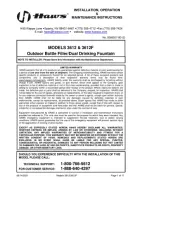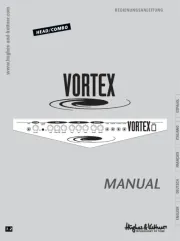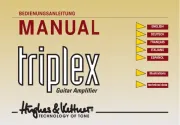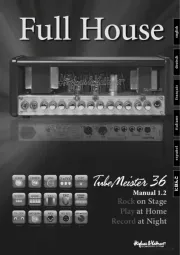Trident 80B Handleiding
Bekijk gratis de handleiding van Trident 80B (8 pagina’s), behorend tot de categorie Niet gecategoriseerd. Deze gids werd als nuttig beoordeeld door 76 mensen en kreeg gemiddeld 4.8 sterren uit 38.5 reviews. Heb je een vraag over Trident 80B of wil je andere gebruikers van dit product iets vragen? Stel een vraag
Pagina 1/8

L E G E N D A R Y E Q U A L I Z A T I O N
80B 500 Series EQ User Manual

The Equalizer
For those not familiar with the dierence
between a shelving and peaking equaliser,
the dierences are as follows. A shelving
equaliser boosts (or attenuates) all fre-
quencies equally, above or below a certain
point. The frequency specified for a shelv-
ing equaliser circuit is usually at the point
where it eectively reaches its ‘shelf’ state.
A ‘high shelf’ EQ boosts/cuts high frequen-
cies and a ‘low shelf’ type boosts/cuts low
frequencies. This type of circuit is very pop-
ular in hi-fi systems but is also actually high-
ly musical, when applied in a recording en-
vironment. In contrast, a peaking equaliser
is one that, as its name implies, has a centre
frequency that is boosted or attenuated
more than others.
The frequency range over which it reach-
es its peak and then falls down is known
as the bandwidth (or ‘Q’). Because this
type of design reaches a peak and then
falls away, it is possible with this type of
circuit to ‘home in’ on particular frequen-
cies and make adjustments without af-
fecting those around them. This can be
particularly useful when working with in-
struments such as bass guitars and snare
drums. By incorporating both shelving
and peaking equalisers into the design of
the 80B, it is possible to get the best of
both types of design.
Operating
The Equalizer
2Trident Audio Developments | 80B EQ 500 Series User Manual
Begin with all boost/cut controls - those with centre detents, set to their
mid way positions. Adjust the low and high mid frequency sweep ‘0’
controls to their minimum positions (fully anticlockwise). The 50Hz high
pass ‘Filter’ switch should be in the out position. Set the frequency select
switches controlling the high and low shelving sections, to 120Hz and
12kHz respectively. Lastly, set the ‘EQ’ switch to the ‘in’ position (the as-
sociated LED will illuminate).

3Trident Audio Developments | 80B EQ 500 Series User Manual
Operating The Equalizer
Rotation of the high frequency shelving control in a clockwise direction
emphasises high frequencies, while turning the control in an anti-clock-
wise direction from centre attenuates high frequencies.
Operating the switch in the high frequency section ‘frequency select’
introduces a subtle change of emphasis to the aected high frequencies,
as the shelving ‘knee’ is changed from 12kHz to 5kHz. Likewise, rotating
the low frequency shelving control in a clockwise direction will emphasise
low frequencies, while turning the control in an anti-clockwise direction
from centre attenuates low frequencies. Adjusting the ‘frequency select’
switch in the low section introduces a subtle change of emphasis on the
aected low frequencies by altering the shelving point from 120Hz down
to 60Hz.
The ‘low mid’ ‘high mid’ and equaliser sections are peaking filters. Adjust-
ment of their parameters is achieved by use of the boost/cut knob and
its associated frequency sweep knob. Boost or cut of a given frequency is
performed by moving that control from its centre detent position: clock-
wise for boost, anti-clockwise to cut. The frequency to be boosted or cut
is selected by the frequency sweep control knob. The range of frequen-
cies of the ‘low mid’ control extends from 100Hz up to 1.5kHz.
For the sweep, the frequency range begins at 1kHz (overlap‘high mid’ -
ping with the low mid section) and continues up to 15kHz.
The Series 80B 500 Series EQ incorporates a classic four band equalis-
er which is identical to that employed in the Trident Series 80 console.
It consists of frequency switchable high and low pass shelving sections,
coupled with two swept low and high mid range bands and a switchable
50Hz, 12dB per octave filter. Both swept midranges have been carefully
chosen for maximum eect on music programme and a good degree of
overlap is provided.
Finally, selecting the switch introduces a smooth, 50Hz, 12dB/‘Filter’
octave roll-o to eectively eliminate ‘rumble’ caused by, among other
things, someone’s feet moving about near a microphone stand, nearby
trac noise and AC systems. The amount of boost (accentuation) or cut
(attenuation) that is applied to the audio signal is entirely dependent on
the programme content and it is not our intention to advise on this. Ap-
plication of equalisation is a very subjective matter and is best learned by
experiment. The equaliser bypass switch ‘EQ’ is a useful facility for com-
paring the signal before and after the application of equalization.
Product specificaties
| Merk: | Trident |
| Categorie: | Niet gecategoriseerd |
| Model: | 80B |
Heb je hulp nodig?
Als je hulp nodig hebt met Trident 80B stel dan hieronder een vraag en andere gebruikers zullen je antwoorden
Handleiding Niet gecategoriseerd Trident

7 December 2023

13 September 2023

12 September 2023

12 September 2023
Handleiding Niet gecategoriseerd
- CradlePoint
- Losi
- Hortus
- Blanco
- Salton
- Sony Optiarc
- Ideal
- Grand Effects
- Gustavsberg
- Edikio
- LC-Power
- Gossen Metrawatt
- WHD
- Sherlock
- Privileg
Nieuwste handleidingen voor Niet gecategoriseerd

17 September 2025

17 September 2025

17 September 2025

17 September 2025

17 September 2025

17 September 2025

17 September 2025

17 September 2025

17 September 2025

17 September 2025